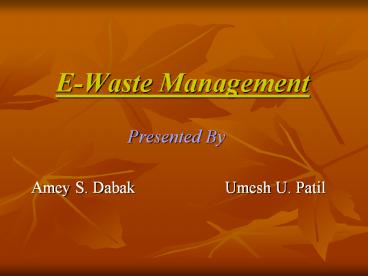E-Waste Management - PowerPoint PPT Presentation
Title: E-Waste Management
1
E-Waste Management
- Presented By
- Amey S. Dabak Umesh U.
Patil
2
Definition
- Electronic waste, popularly known as e-waste
can be defined as electronic equipments or
products connects with power plug, batteries
which have become obsolete due to 1.
Advancement in technology 2. Changes in
fashion, style and status 3. Nearing the
end of their useful life.
3
Classification of e-waste
- E-waste encompasses ever growing range of
obsolete products classified as - Electronic devices such as computers, servers,
main frames, monitors, TVs display devices - Telecommunication devices such as cellular phones
pagers, calculators, audio and video devices,
printers, scanners, fax machines, refrigerators,
air conditioners, washing machines, and microwave
ovens.
4
- 3. Recording devices such as DVDs, CDs, floppies,
tapes, printing cartridges, military electronic
waste, automobile catalytic converters. - 4. Electronic components such as chips,
processors, mother boards, printed circuit
boards, industrial electronics such as sensors,
alarms, sirens, security devices, automobile
electronic devices.
5
Need of E-Waste Management
- Industrial Revolution.
- Advancement in Information Technology.
- There mismanagement can lead to the pollution.
- From the data collected, in a single year the
production is around 1200 tons of electronic
scrap.
6
- Production of E-Waste is on mass basis in many
developed countries including India. - This waste is not Eco-friendly.
- Hence there is a need to check this electronic
waste pollution by proper management.
7
Sources of E-Waste
8
(No Transcript)
9
E-Waste Deposition
10
Composition of E-Waste
11
Effects of E-Waste constituent on health
Source of e-waste Constituent Health effects
Solder in printed circuit boards, glass panels and gaskets in computer monitors Lead (PB) Damage to nervous and blood systems. kidney damage. Affects brain development.
12
Chip resistors and semiconductors Relays and switches, printed circuit boards Front panel of CRTs Cadmium (CD) Mercury (Hg) Barium (Ba) Toxic irreversible effects. Accumulates in kidney and liver. Neural damage. Damage to brain. Respiratory and skin disorders. Muscle weakness Damage to heart, liver and skin.
13
Cabling and computer housing Motherboard Plastics including PVC Beryllium (Be) Immune system damage, Interfere with regulatory hormones. Lung cancer Skin diseases such as warts.
14
Management Of E-waste
- Due to advancement in techniques the old
instruments are becoming outdated. - This necessitates implemental management
measures. - India as a developing country needs simpler, low
cost technology for proper management of E-waste.
15
- In industries management of e-waste should begin
at the point of generation. - Waste minimization in industries involves
adopting - 1. inventory management,
- 2. production-process modification,
- 3. volume reduction,
- 4. Recovery and reuse.
16
Management Options
- Considering the severity of the problem, it is
imperative that certain management options must
be adopted to handle the bulk e-wastes. - Following are some of the management options
suggested for the government, industries and the
public.
17
Responsibilities of the Government
- Government should set up regulatory agencies.
- Government should provide an adequate system of
laws and controls. - Government must encourage research into the
development and production of less hazardous
equipments.
18
Responsibility and Role of industries
- Generators of wastes should take responsibility
to determine the output characteristics of
wastes. - All involved person should be properly qualified
and trained in handling e-waste in industries. - Companies should adopt waste minimization
techniques.
19
Responsibilities of the Citizen
- Reuse
- Donating used electronics to schools, non-profit
organizations, and lower-income families. - E-wastes should never be disposed with garbage
and other household wastes. - These wastes should be collected at a separate
site and they should be sent for various
processes like Reuse, Recycling, and Donating.
20
Conclusion
- E-waste is going to create lot of problems in
future. - E-Waste management is of utmost importance.
- Proper management is necessary to minimize its
ill effects on human beings and nature.
21
Thank You

